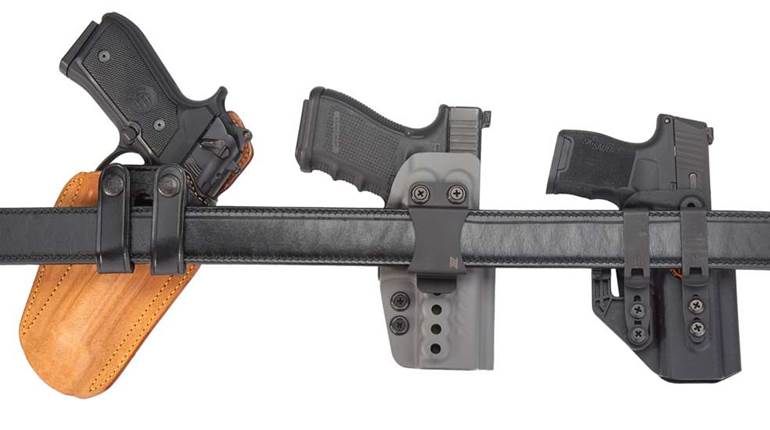
This article was originally published in American Rifleman, Feb. 2010. Rohrbaugh was purchased by Remington in 2014, thus the R380 has since been re-introduced as the RM380.
The lure of the little gun is stronger than ever. The ranks of new CCW permit holders are growing steadily, and few choose a big gun for daily carry. Although weight and size invariably accompany a gun that is the best possible choice for defensive use, most people simply won’t make a habit of carrying a heavy, bulky gun.
It is obvious that smaller and lighter handguns may be a compromise of a sort, but they nonetheless place respectable power into more of the right hands. In this article we’ll look at the characteristics and performance of nine different guns that represent a new trend toward the lightest, smallest pistols chambered for the century-old .380 ACP cartridge. Most are new to the market, and all are examples of modern gunmakers responding to consumer demand.
But first let's look at the .380 ACP cartridge. Also known as the 9 mm Corto, 9 mm Kurz and 9x17 mm in Europe, the .380 was first used in an American pistol: the Pocket Model Colt of 1908. It is a short 9 mm round using bullets of 0.355" diameter and 80 to 110 grs. in weight at approximately 900 f.p.s. from the muzzle. In the United States, the cartridge has a long-standing association with some pretty classy semi-automatics from Colt, Remington and others. Many quality .380 pistols came from Europe in the first half of the century, either by import or in the duffle bags of G.I.s returning from our two European wars. After World War II, many other pistols came to America from Spain, Italy, Germany, Austria and France.
American ammunition companies load the .380 ACP with a variety of bullet types. Recoil of the .380 ACP is bearable for almost all CCW holders, and most guns for which it is chambered are easy to carry. For most of the lifetime of the .380, the guns that used it were simple blowback designs in which a combination of slide weight and recoil spring tension held the breech closed until the bullet left the muzzle and pressure dropped.
In the nine pistols reviewed here only two use this system, which requires a fairly heavy slide. The other seven are recoil-operated guns using some form of tilting barrel lockup. In short, these .380s use an operating system that is also found on similar pistols chambered in 9 mm Luger, .40 S&W and other cartridges. In this way, the .380 pistol manufacturer can reduce its weight and bulk. Several in the lineup are very compact pistols that weigh less than 10 ozs. This effectively fills the bill for shooters who demand light weight, compact dimensions and overall shootability in their CCW gun. If they can accept the limitations of the ammunition, it is an appealing concept.
The guns are—in alphabetical order—the Kahr P380, Kel-Tec P3AT, Magnum Research Micro, North American Arms Guardian, Rohrbaugh R380, Ruger LCP, SIG Sauer P238, Taurus 738 TCP and Walther PK380. There is a great deal of variety, with prices running from a low of $318 to a high of $1,150. Weights range from a low of 8.30 ozs. to a high of 19.72 ozs. Following is a description of each gun in capsule form.
Kahr P380
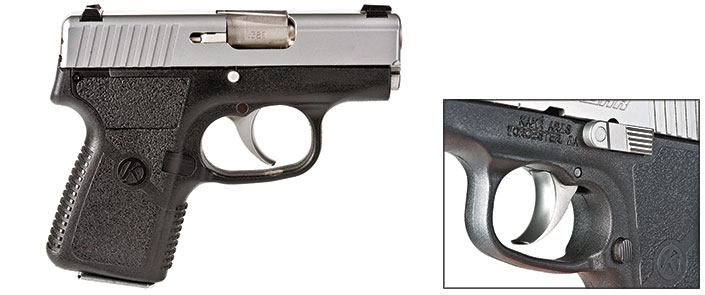
Kahr’s little .380 is the latest and smallest pistol in its now-extensive line. Kahr's first larger-caliber pistols had steel receivers, but the demands of the CCW crowd drove it to develop a polymer receiver applicable to all calibers. It is the polymer receiver that is used for the .380. Like other Kahrs, the gun is a recoil-operated, striker-fired double-action-only (DAO) design with a relatively smooth, if rather long, trigger pull. The Kahr has many of the good features of full-size semi-automatics, not the least of which is sights dovetailed into the slide. A flat pistol (because of a clever offset feed ramp), the Kahr conceals easily and has no sharp edges or corners to impede the draw stroke. In Kahr’s brief history armed professionals have accepted and have regularly carried the company’s guns. At the range, I found the pistol to be of sound ergonomic design and easy to manage. There were several malfunctions—usually failures to chamber. I have to note that Kahr states in its literature that its pistols need to be fired at least 200 rounds before going into active service as a defensive firearm.
Kel-Tec P3AT
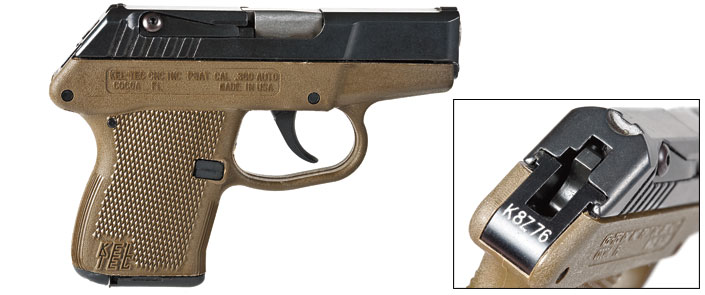
The single most important criteria in selecting a gun for habitual carry is weight—as long as the gun in question is enough gun for the job. If you are considering a .380, you cannot find one that is lighter than the 8.3-oz. P3AT. While Kel-Tec has branched off into some interesting long guns in recent years, the firm’s bread and butter has been small semi-automatic pistols at low prices. It actually makes a smaller and lighter version of this gun in .32 ACP. Using a light, slim polymer receiver that houses the lockwork and a single-column magazine of six rounds, the P3AT is indeed a light, small package. It’s a hammer-fired DAO, in which the mass of the hammer is concentrated around the point of pivot. The gun is not easy to shoot, in that the sights are small and hard to see, and it has too many sharp edges and corners. Further, the P3AT is prone to malfunction with several kinds of ammunition. I suspect that the Kel-Tec needs a great deal of breaking-in before it goes into service.
Magnum Research Micro Desert Eagle
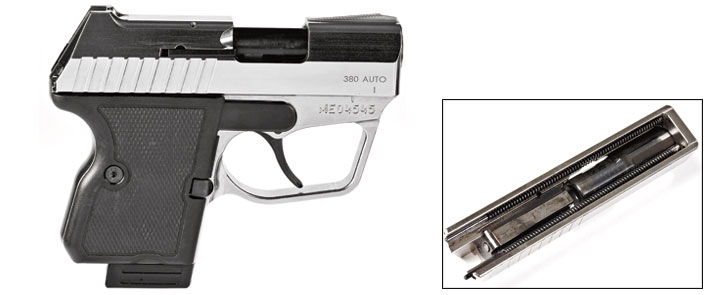
The Micro is a new model that stands in sharp contrast to the rest of the company’s assortment of big, powerful Desert Eagle semi-automatic pistols and BFR revolvers. But, even though the Micro Desert Eagle is small, it is made almost completely of steel, so it is comparatively heavy. Another DAO, the gun retains the blowback system used on so many earlier .380s. None of our sample .380s afford the shooter a hand-filling grip, but the Micro seems especially hard to get a shooting grip. Modernistic in its styling, the six-plus-one pistol has square notch rear and post front sights of diminutive proportions. As the gun wears a high polish finish in a bright silver color, it is tough to obtain a good sight picture in daylight. Further, the pistol has a very heavy trigger pull and a number of sharp edges. Add a rather sharp recoil impulse (in part because of the blowback operation) and you have a gun that is challenging to shoot. In the shooting session, I encountered malfunctions in both feeding and chambering.
North American Arms Guardian
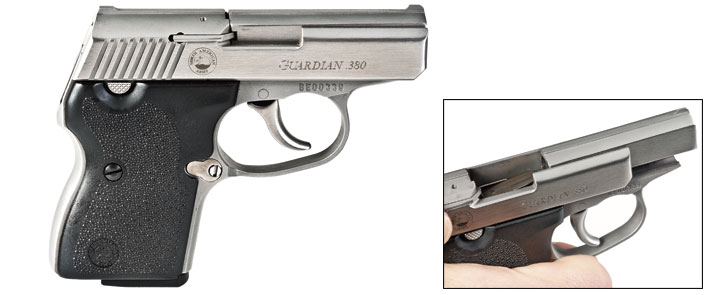
The Guardian comes from a maker of small revolvers in .22 LR and .22 Mag. From the outset, I was impressed with the obvious care taken in the fit and finish of this little blowback semi-automatic. It is carefully machined and polished; even the grip panels are precisely molded with a pebble grain surface, and markings on the slide are crisp and sharp. All in all it is a nice-looking, handsomely styled pocket pistol. At 18.72 ozs., it is rather heavy, but the size is comparable to the other guns in this review. The NAA Guardian is all-steel, which explains the weight. There is further need to have a heavy slide on a blowback pistol, particularly when it is to be fired with today’s rather zippy .380 loads. In shooting the Guardian, I found there was not a lot of space for my sausage-like trigger finger in the guard. It also had a rather heavy trigger pull and a long reset. Its small, shiny sights were hard to see. Several malfunctions suggest that the Guardian is another pistol that needs extensive breaking-in.
Rohrbaugh R380
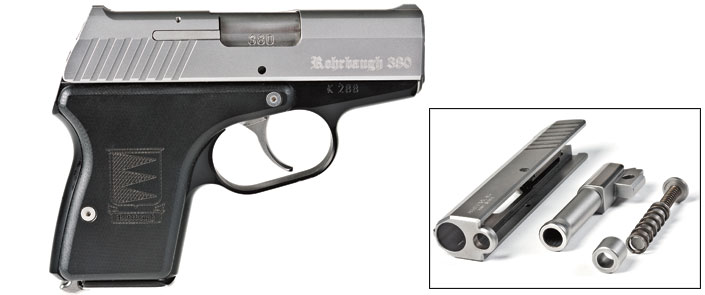
Inventor and maker of the pistol that bears his name, Karl Rohrbaugh offers exactly the same gun as this one, except that it is in 9 mm. By any measuring stick, the 9 mm is a far better service round than the .380, so I was curious as to why he built the pistol. The answer is because a corps of loyal and vocal fans wanted it for recoil-sensitive shooters in their families. He made the necessary changes to his 9 mm pistol and the resulting .380s are selling briskly. Small wonder, this is an exceedingly well-designed and well-made handgun. Using aluminum receivers topped by steel slides and barrels, R380s feature a recoil-operated system. They have a hammer-fired, DAO lockwork, as well as an unusual heel-mounted magazine catch. Rohrbaugh’s 9 mm pistols are offered with either small sights integral with the slide or no sights at all. The sights are too small to see for any precise shooting, making our accuracy protocol problematic. Gunsite Rangemaster Chris Weare and I did not encounter trigger control issues because the out-of-the-box trigger is very good to excellent. The Rohrbaugh did not malfunction.
Ruger LCP
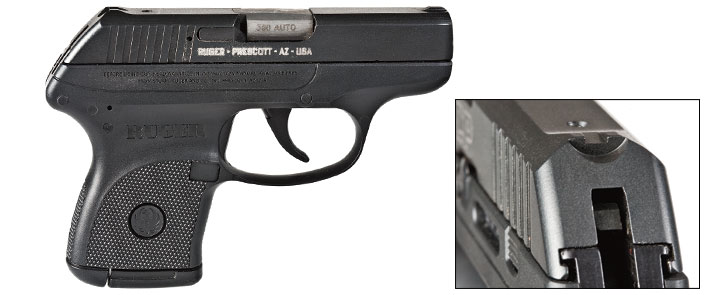
A good bit of the interest in small .380s stems from the introduction of this pistol at the 2008 SHOT Show. Several of our nine-gun assortment pre-date the little Ruger, but it is the one that ignited such intense popularity in tiny .380s. It’s easy to see why; the Ruger is an appealing little gun. With a glass-filled nylon lower topped with a steel barrel and slide, the LCP is a recoil-operated gun with DAO lockwork and a speed hammer. The gun is not only small and light, but also relatively thin—just about eight-tenths of an inch. Recoil is snappy and almost painful. In anything but bright daylight, the tiny sights preclude a proper sight picture. Although the Ruger is an uncommonly handsome little rascal, it has a number of edges and corners that you just can’t design out of the gun. We had problems getting through the shooting evaluation. That included a number of feedway malfunctions, which were puzzling. It was the same pistol I had written up shortly after it was introduced. There were no problems then, but a new array of different loads resulted in some jams. I must conclude that the LCP is a bit ammunition-sensitive and you have to pick your loads carefully to keep it running.
SIG Sauer P238
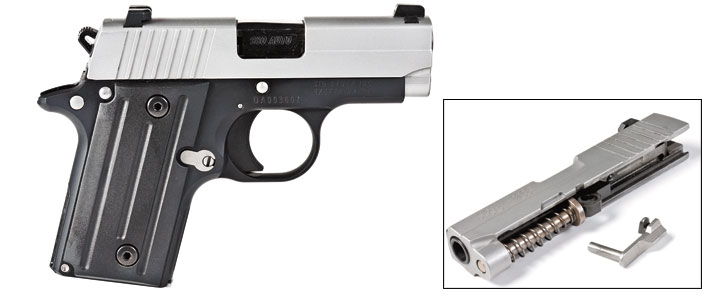
It is kind of surprising that SIG Sauer’s little .380 took the form that it did. For a company that made its bones on advanced DA/SA and DAO pistols, we now have a little gun that is an old-fashioned single-action. In fact, in both appearance and handling, this is a baby M1911. It uses a version of the same tilting barrel recoil operation, the same push-down-to-fire safety and general physical layout. That includes decent-size sights dovetailed into the slide, a magazine catch aft of the trigger guard on the left side and a single-action trigger that works only to release a cocked hammer. As much as the P238 system is similar to the M1911, it is in one way superior. The safety is arranged in such a way that the slide will move with the safety up and on. This means that you can engage the safety for all manipulations of the pistol—loading, clearing jams, etc. Since the safety is important to the function of the pistol, I would choose to carry it “cocked and locked” in some form of holster. The trigger system and readily visible sights made this one easy to shoot. It too exhibited malfunctions, however, with the most common being failures to chamber.
Taurus 738 TCP
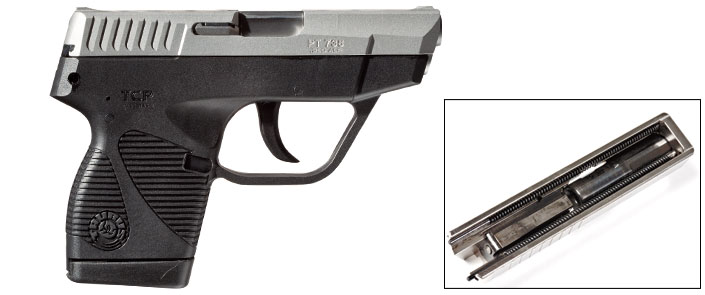
TCP is an abbreviation for “Taurus Compact Pistol,” and the actual gun is a brand-new model in the Taurus catalog—just in time for the “Great .380 Wars.” A molded polymer lower topped with a steel slide combine with a typical recoil-operated system and DAO trigger to produce a little pistol in .380 caliber. The Brazilian designers gave this gun a racy and futuristic look. As it is with several other guns in our series, the TCP has sights integral to the slide that are black and quite small. Such a light gun produces sharp recoil, particularly with the speedy Speer Gold Dot ammunition, so its accuracy was only adequate. A brand-new pistol when we first fired it, the TCP stuttered only twice in the course of a hundred rounds or so. Modestly priced, the Taurus would seem to be a decent choice for the CCW gunner on a budget. Also, the TCP comes with a nicely constructed nylon case that clips to your belt and looks like it holds some electronic gizmo—concealed in plain sight, as it were.
Walther PK380
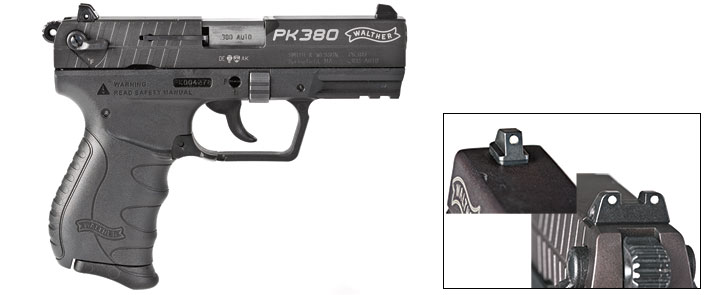
This Walther bears little resemblance to the legendary PP and PPK pistols. It is also well away from the size and weight ranges seen in the other eight guns. It differs in that it is the only pistol under consideration that has a form of DA/SA lockwork. This made the shooting exercises a good bit easier than with the other guns, although there were still a few malfunctions. We used the single-action aspect of the trigger system. The generous butt section and large adjustable sights made it even easier. This design actually began with the company’s inexpensive rimfire pistol, which has the same receiver shell. They put a different slide on top and added proper sights to produce a nice, medium-size .380 pistol. With modernistic styling, the PK380 is rakish-looking, and that alone will sell some guns. Don’t be confused by the Walther-like lever on the rear of the slide. It is nothing more than a safety block that pivots into the path of the hammer, preventing a strike on the firing pin. It is not the decocker mechanism we are used to seeing on Walthers.
Click here for Test Results
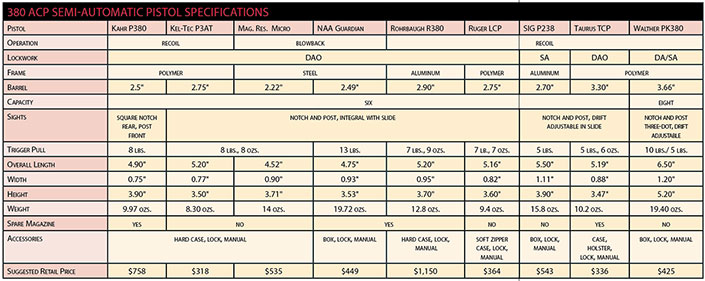
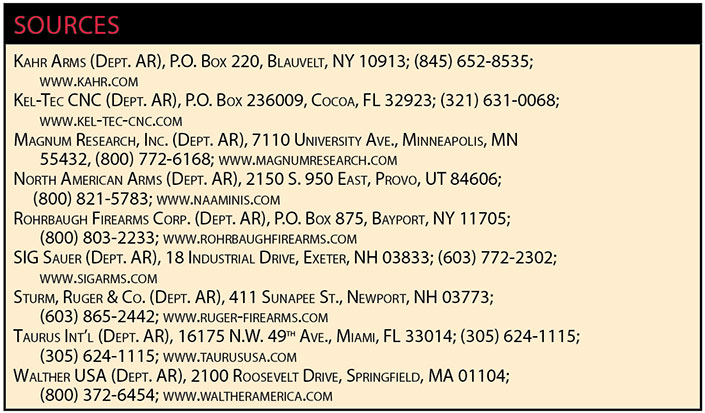
Shooting The Guns
Each pistol tested got an equal shot in the evaluation process. I fired the American Rifleman protocol of five consecutive, five-shot groups, plus a half-dozen or so magazines of informal shooting. That’s roughly 100 rounds per gun. These guns are intended for sudden crisis encounters at very close range. For that reason, I would not be too concerned about the performance of the guns at 25 yds. When I report that the average group size is more than 6", that means the gun doesn’t compare very well to, say, a S&W Performance Center M1911. It is apples and oranges. I can tell you they will all cluster seven rounds into a group the size of your hand at 5 yds.
I am concerned about the number of cycling malfunctions, most commonly failures to feed and chamber. With one exception, every gun experienced these problems. Even here, we have to put matters in context. Kahr Arms, for example, includes the same manual with each of its pistols, regardless of size or chambering. That manual tells the buyer that he or she needs to run at least 200 rounds through the pistol before pressing it into service. That is coldly realistic advice that all of the other manufacturers would be well-advised to emulate.
With most of the guns, the greater number of glitches came when they were new out of the box. As the shooting wore on, the frequency of malfunctions declined. I would also suggest that when breaking in your chosen .380, you should make sure the gun is well-lubricated, perhaps even over-lubricated. Shoot until malfunctions stop.
This diverse lineup of .380 ACP pistols provides many choices to the defensive handgunner who wants a light, small, shootable handgun at a conservative price.












